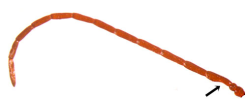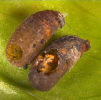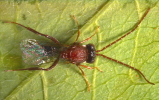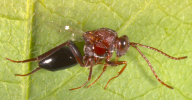Scientific name
Callaspidia notata (Boyer de Fonscolombe) (=C. rufithorax
(Cameron))
Taxonomic position
Hymenoptera: Cynipoidea: Figitidae
Diagnosis
Male: Head black, antennae, thorax and legs dark reddish brown, hind legs slightly darker than other pairs, gaster (abdomen) shiny black and smooth. Antenna filiform, 14-segmented, third segment with outer margin distinctly curved. Scutellum with prominent ridges and pits. Gaster distinctly petiolate, laterally compressed, gastral tergites nearly contiguous ventrally.
Female: Head, antennae, thorax and legs reddish brown, abdomen shiny black. Antenna 13-segmented, third segment with outer margin straight. Otherwise similar to male.
Commonly collected parasitising syrphids.
 Male antenna Male antenna

 Head and thorax - dorsal and lateral view Head and thorax - dorsal and lateral view
Images
 Puparia of Ischiodon scutellaris (F.) with emergence holes Puparia of Ischiodon scutellaris (F.) with emergence holes


 Adult male, dorsal view Adult male, dorsal view

 Adult female, lateral view Adult female, lateral view
Distribution
Commonly distributed all over India.
Hosts / Biology
Callaspidia spp. are primary, solitary endoparasitoids, mainly of larvae and pupae of Syrphidae (hover flies). Parasitised pupae turn dark brown to black. C. rufithorax is commonly collected as a parasitoid of syrphids such as Ischiodon scutellaris (F.).
References
- Morphbank (database of SEM images of common genera of Figitidae and their
characters).
- Weld, L. H. 1951. Cynipoidea. Private Printing, Ann Arbor, Michigan. 351 p.
|